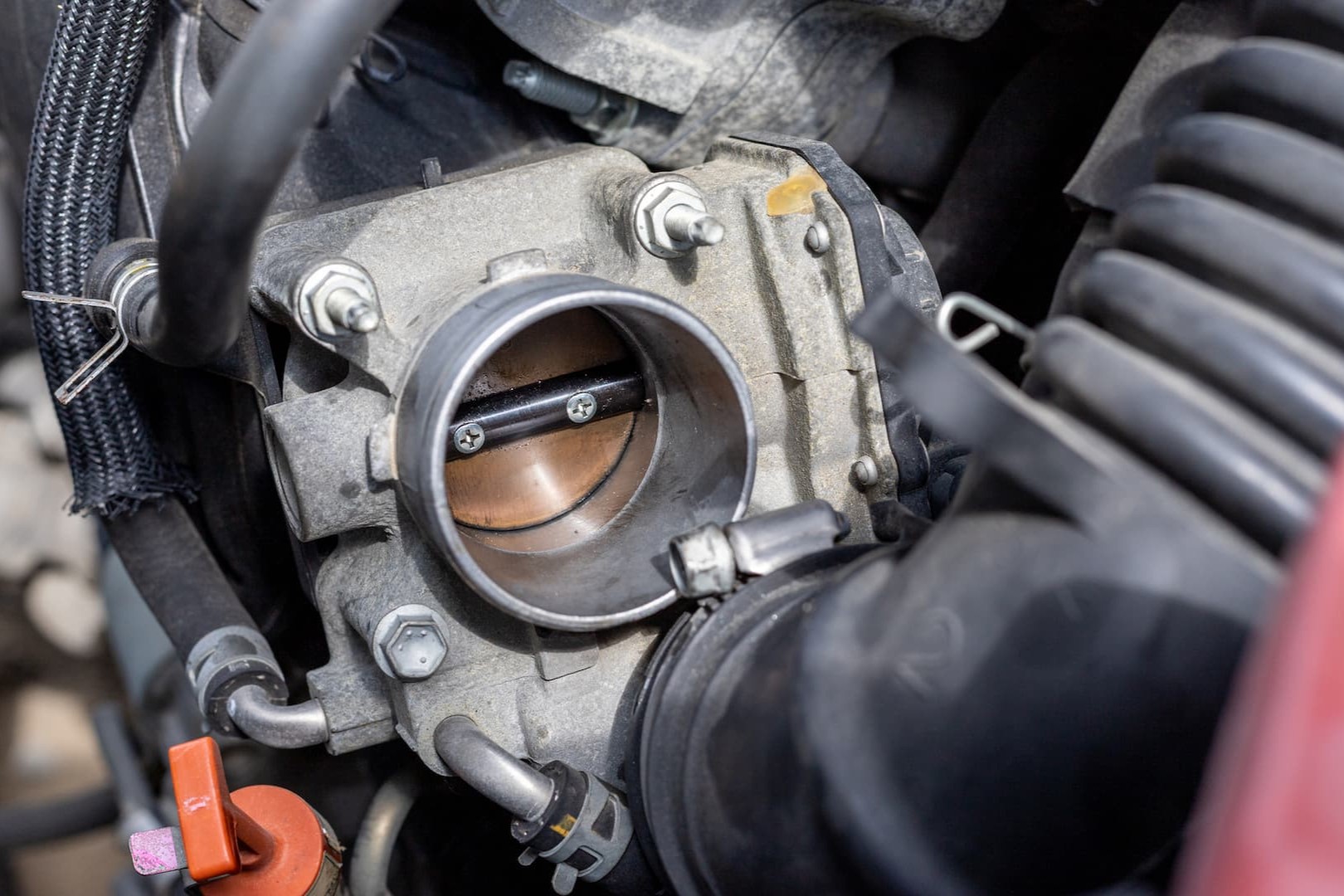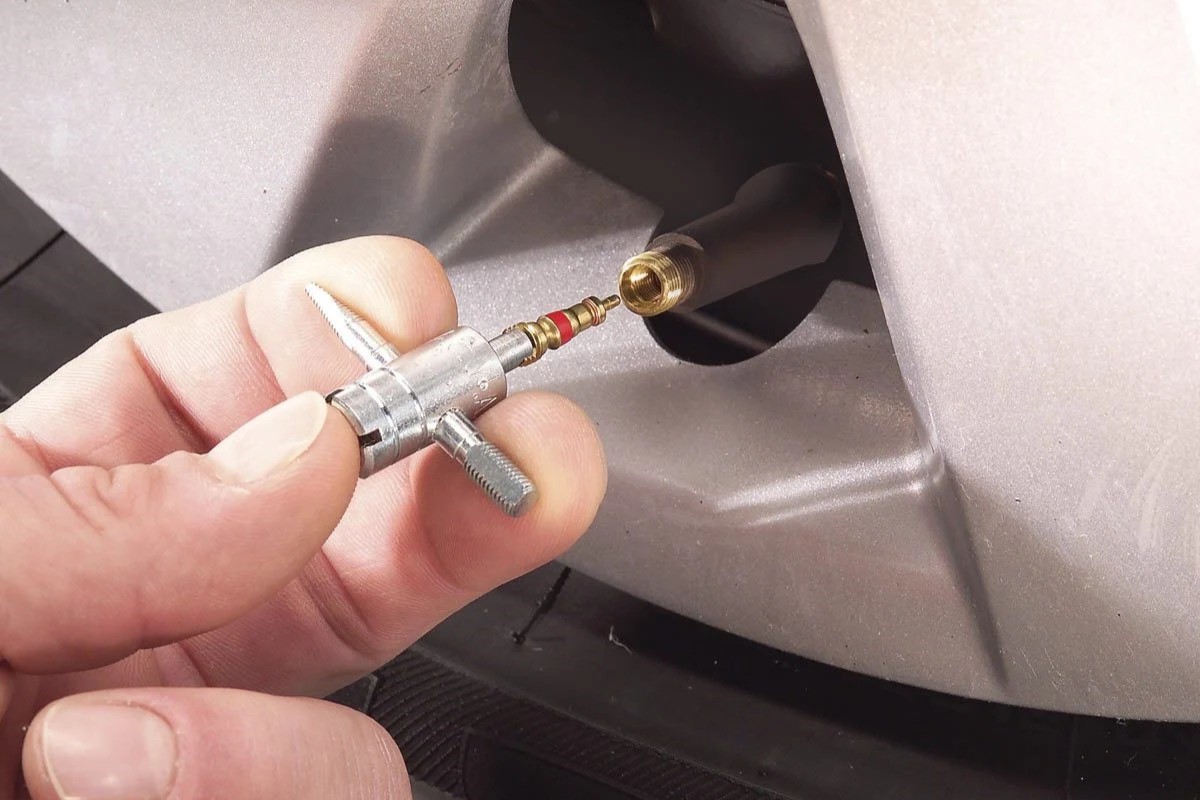Home>Automotive>10 Surprising Signs Of A Faulty Or Blocked IAC Valve


Automotive
10 Surprising Signs Of A Faulty Or Blocked IAC Valve
Published: January 5, 2024
Discover 10 unexpected indicators of a malfunctioning or obstructed IAC valve in the automotive industry. Learn how to identify and address issues with your vehicle's idle air control valve.
(Many of the links in this article redirect to a specific reviewed product. Your purchase of these products through affiliate links helps to generate commission for Noodls.com, at no extra cost. Learn more)
Table of Contents
Introduction
When it comes to the smooth operation of your vehicle, every component plays a crucial role. One such component that often goes unnoticed but is essential for the proper functioning of the engine is the Idle Air Control (IAC) valve. The IAC valve, also known as the idle speed control valve, is a vital part of the engine's air management system. It regulates the amount of air entering the engine at idle, ensuring that the engine maintains a steady and consistent idle speed.
The IAC valve's primary function is to adjust the engine's idle speed based on various factors such as engine temperature, electrical load, and air conditioning usage. By controlling the airflow during idle conditions, the IAC valve helps to maintain a stable and efficient idle speed, ensuring that the engine runs smoothly even when the vehicle is stationary.
However, like any other mechanical component, the IAC valve is susceptible to wear and tear over time. When the IAC valve malfunctions or becomes blocked, it can lead to a myriad of issues that can significantly affect the performance and drivability of the vehicle. Recognizing the signs of a faulty or blocked IAC valve is crucial for ensuring the proper maintenance and operation of your vehicle.
In this article, we will delve into the ten surprising signs that indicate a potential issue with your vehicle's IAC valve. By understanding these signs, you can take proactive measures to address any underlying problems, thereby safeguarding the optimal performance of your vehicle. So, let's embark on this insightful journey to uncover the telltale signs of a faulty or blocked IAC valve and equip ourselves with the knowledge to keep our vehicles running smoothly.
What is an IAC Valve?
The Idle Air Control (IAC) valve, an integral component of the engine's air management system, serves a crucial function in regulating the engine's idle speed. Operating in conjunction with the engine control unit (ECU), the IAC valve precisely controls the airflow into the engine during idle conditions. This control is essential to maintain a consistent and stable idle speed, ensuring that the engine runs smoothly and efficiently, particularly when the vehicle is stationary.
The IAC valve achieves this by adjusting the amount of air entering the engine based on various factors, including engine temperature, electrical load, and air conditioning usage. By continuously monitoring and modulating the airflow, the IAC valve enables the engine to maintain a steady idle speed, compensating for fluctuations in operating conditions.
Typically, the IAC valve is positioned in the throttle body or intake manifold, allowing it to directly influence the engine's air intake. When the throttle is closed, such as during idle or deceleration, the IAC valve assumes control of the engine's air supply, playing a pivotal role in sustaining the desired idle speed.
In modern vehicles, the IAC valve is often electronically controlled, utilizing a stepper motor or solenoid to precisely adjust the airflow. This electronic control enables the ECU to fine-tune the engine's idle speed in response to dynamic operating parameters, optimizing performance and fuel efficiency.
The IAC valve's significance becomes evident in its ability to adapt to varying driving conditions and engine loads, ensuring a seamless transition between different operational states. By facilitating a stable and consistent idle speed, the IAC valve contributes to the overall drivability and performance of the vehicle, enhancing the driver's experience and the engine's operational efficiency.
In essence, the IAC valve plays a pivotal role in maintaining the engine's stability and efficiency during idle conditions, underscoring its significance as a fundamental component of the vehicle's air management system. Understanding the function and importance of the IAC valve is essential for recognizing its impact on the vehicle's performance and identifying potential issues that may arise when the valve malfunctions or becomes obstructed.
Sign 1: Engine Stalling
Engine stalling, a disconcerting occurrence that can abruptly disrupt the smooth operation of a vehicle, often serves as a prominent indicator of a potential issue with the Idle Air Control (IAC) valve. When the IAC valve malfunctions or becomes obstructed, it can lead to irregularities in the engine's idle speed, ultimately culminating in unexpected stalling episodes.
The engine stalling phenomenon manifests as the sudden cessation of the engine's operation, typically occurring when the vehicle is stationary or during deceleration. This abrupt interruption in engine function can be alarming and inconvenient, posing safety concerns and impeding the vehicle's drivability. Understanding the underlying causes of engine stalling is imperative for diagnosing potential IAC valve-related issues and implementing appropriate remedial measures.
A faulty or blocked IAC valve can disrupt the engine's idle speed control, leading to unstable idling and, in severe cases, causing the engine to stall unexpectedly. The malfunctioning IAC valve may fail to regulate the airflow accurately during idle conditions, resulting in insufficient air supply to sustain the engine's operation at a consistent idle speed. As a consequence, the engine may experience intermittent stalling, particularly when the vehicle comes to a stop or when the throttle is released, signifying a potential correlation with the IAC valve's functionality.
Moreover, the engine stalling associated with a faulty IAC valve may be exacerbated by variations in operating conditions, such as changes in engine temperature, electrical load, or air conditioning usage. These dynamic factors can further accentuate the irregularities in idle speed control, amplifying the likelihood of engine stalling occurrences.
Recognizing the manifestation of engine stalling as a potential symptom of a malfunctioning or obstructed IAC valve is essential for preemptive maintenance and troubleshooting. Addressing the underlying issues promptly can prevent prolonged inconvenience and mitigate the risk of unexpected stalling, safeguarding the vehicle's operational integrity and the driver's safety.
In essence, engine stalling serves as a compelling sign that warrants attention and intervention, prompting a comprehensive assessment of the vehicle's IAC valve and its associated components. By identifying and addressing the root causes of engine stalling, particularly in relation to the IAC valve's functionality, vehicle owners can uphold the optimal performance and reliability of their vehicles, ensuring a seamless and uninterrupted driving experience.
Sign 2: Rough Idle
A rough idle, characterized by an irregular and unsettled engine operation during stationary periods, is a compelling indicator of potential issues with the Idle Air Control (IAC) valve. When the IAC valve malfunctions or becomes obstructed, it can disrupt the engine's ability to maintain a smooth and consistent idle speed, resulting in the manifestation of rough idling symptoms.
The phenomenon of rough idle is discernible through noticeable fluctuations in the engine's RPM (revolutions per minute) while the vehicle is stationary, such as when at a stoplight or in park. Instead of maintaining a steady and uniform idle speed, the engine may exhibit erratic behavior, including fluctuations in RPM, intermittent surges, or a perceptible sense of unsteadiness. This irregular and unsettled engine operation is indicative of underlying issues that may be attributed to the malfunctioning or blockage of the IAC valve.
A faulty or obstructed IAC valve can impede the precise regulation of airflow into the engine during idle conditions, leading to an imbalance in air-fuel mixture and combustion. This imbalance can manifest as rough idling, wherein the engine struggles to maintain a consistent and stable idle speed, resulting in perceptible vibrations, fluctuations in RPM, and an overall sense of unease in the engine's operation.
Furthermore, the manifestation of rough idle may be exacerbated by variations in operating parameters, such as changes in engine temperature, electrical load, or air conditioning usage. These dynamic factors can further accentuate the irregularities in idle speed control, amplifying the prominence of rough idling symptoms and underscoring the potential correlation with the functionality of the IAC valve.
Recognizing rough idle as a prominent sign of a potential issue with the IAC valve is pivotal for proactive maintenance and diagnostic measures. By addressing the underlying causes of rough idling and conducting a comprehensive assessment of the IAC valve and its associated components, vehicle owners can mitigate the impact of irregular engine operation, ensuring the optimal performance and drivability of their vehicles.
In essence, the manifestation of rough idle serves as a compelling indication of underlying issues related to the IAC valve, prompting a thorough evaluation and remedial actions to restore the engine's smooth and consistent idle operation. By identifying and addressing the root causes of rough idling, particularly in relation to the IAC valve's functionality, vehicle owners can uphold the operational integrity of their vehicles, fostering a seamless and enjoyable driving experience.
Sign 3: Engine Surging
Engine surging, a perplexing and disconcerting phenomenon characterized by erratic fluctuations in the engine's RPM (revolutions per minute), serves as a compelling indicator of potential issues with the Idle Air Control (IAC) valve. When the IAC valve malfunctions or becomes obstructed, it can disrupt the precise regulation of airflow into the engine during idle conditions, leading to the manifestation of engine surging symptoms.
The manifestation of engine surging is discernible through irregular and abrupt fluctuations in the engine's RPM, often resembling a repetitive pattern of acceleration and deceleration. This erratic behavior deviates from the smooth and consistent idle operation, causing the engine to surge or hesitate intermittently, even when the vehicle is stationary. The perceptible sense of unsteadiness and fluctuation in RPM reflects the underlying irregularities in idle speed control, indicative of potential issues associated with the functionality of the IAC valve.
A faulty or obstructed IAC valve can disrupt the engine's ability to maintain a stable and uniform idle speed, leading to the manifestation of surging symptoms. The malfunctioning IAC valve may fail to regulate the airflow accurately during idle conditions, resulting in intermittent surges and hesitations in the engine's operation. This disruption in idle speed control can be exacerbated by dynamic operating parameters, such as changes in engine temperature, electrical load, or air conditioning usage, further accentuating the prominence of engine surging.
Moreover, the manifestation of engine surging can impede the vehicle's drivability and overall operational integrity, posing challenges for the driver and potentially compromising the engine's performance. The irregular and unpredictable fluctuations in RPM can lead to a jarring and unsettling driving experience, underscoring the significance of recognizing engine surging as a compelling sign of potential issues related to the IAC valve.
Recognizing engine surging as a prominent indicator of a potential issue with the IAC valve is pivotal for proactive maintenance and diagnostic measures. By addressing the underlying causes of engine surging and conducting a comprehensive assessment of the IAC valve and its associated components, vehicle owners can mitigate the impact of irregular engine operation, ensuring the optimal performance and drivability of their vehicles.
In essence, the manifestation of engine surging serves as a compelling indication of underlying issues related to the IAC valve, prompting a thorough evaluation and remedial actions to restore the engine's smooth and consistent idle operation. By identifying and addressing the root causes of engine surging, particularly in relation to the IAC valve's functionality, vehicle owners can uphold the operational integrity of their vehicles, fostering a seamless and enjoyable driving experience.
Sign 4: Difficulty Starting the Engine
Experiencing difficulty when starting the engine can be a perplexing and concerning issue for vehicle owners, often signaling potential underlying problems with the Idle Air Control (IAC) valve. When the IAC valve malfunctions or becomes obstructed, it can significantly impact the engine's ability to initiate and maintain a smooth startup sequence, leading to the manifestation of difficulty in starting the engine.
The occurrence of difficulty starting the engine is discernible through prolonged cranking periods, intermittent stalling during startup attempts, or a noticeable struggle in achieving ignition. These symptoms reflect underlying irregularities in the engine's idle speed control, indicative of potential issues associated with the functionality of the IAC valve.
A faulty or obstructed IAC valve can impede the precise regulation of airflow into the engine during startup, leading to insufficient air supply and disruptions in the engine's initial combustion process. This disruption can manifest as prolonged cranking periods, wherein the engine struggles to achieve ignition, or intermittent stalling during startup attempts, reflecting the challenges posed by the malfunctioning IAC valve.
Moreover, the manifestation of difficulty starting the engine can impede the vehicle's operational integrity and pose inconveniences for the driver, particularly during critical startup situations. The struggle to initiate the engine can lead to frustration and uncertainty, underscoring the significance of recognizing difficulty starting the engine as a compelling sign of potential issues related to the IAC valve.
Recognizing difficulty starting the engine as a prominent indicator of a potential issue with the IAC valve is pivotal for proactive maintenance and diagnostic measures. By addressing the underlying causes of difficulty starting the engine and conducting a comprehensive assessment of the IAC valve and its associated components, vehicle owners can mitigate the impact of irregular engine operation, ensuring the optimal performance and drivability of their vehicles.
In essence, the manifestation of difficulty starting the engine serves as a compelling indication of underlying issues related to the IAC valve, prompting a thorough evaluation and remedial actions to restore the engine's smooth startup process. By identifying and addressing the root causes of difficulty starting the engine, particularly in relation to the IAC valve's functionality, vehicle owners can uphold the operational integrity of their vehicles, fostering a seamless and enjoyable driving experience.
Sign 5: Poor Fuel Economy
Poor fuel economy serves as a significant indicator of potential issues related to the Idle Air Control (IAC) valve, shedding light on the intricate interplay between engine performance and fuel efficiency. When the IAC valve malfunctions or becomes obstructed, it can exert a notable influence on the vehicle's fuel consumption, ultimately leading to the manifestation of poor fuel economy.
The phenomenon of poor fuel economy is discernible through an increase in fuel consumption relative to the vehicle's typical usage patterns. This discrepancy becomes evident through a noticeable decline in the vehicle's mileage per gallon, indicative of inefficiencies in the combustion process and the overall utilization of fuel. The underlying irregularities in fuel economy underscore the potential impact of the malfunctioning or obstructed IAC valve on the engine's operational dynamics.
A faulty or obstructed IAC valve can disrupt the precise regulation of airflow into the engine, leading to imbalances in the air-fuel mixture and combustion efficiency. This disruption can result in suboptimal engine performance, characterized by inefficient fuel utilization and increased fuel consumption. The malfunctioning IAC valve may fail to maintain the ideal air-fuel ratio during varying operating conditions, contributing to diminished fuel economy and heightened fuel consumption.
Moreover, the manifestation of poor fuel economy can have tangible implications for vehicle owners, translating into increased fuel expenses and reduced driving range. The inefficiencies stemming from the malfunctioning or obstructed IAC valve can compromise the vehicle's overall fuel efficiency, necessitating a comprehensive assessment of the underlying issues to mitigate the impact on the driver's expenses and the vehicle's environmental footprint.
Recognizing poor fuel economy as a prominent indicator of potential issues with the IAC valve is pivotal for proactive maintenance and diagnostic measures. By addressing the underlying causes of poor fuel economy and conducting a comprehensive evaluation of the IAC valve and its associated components, vehicle owners can mitigate the impact of diminished fuel efficiency, ensuring optimal performance and cost-effective operation of their vehicles.
In essence, the manifestation of poor fuel economy serves as a compelling indication of underlying issues related to the IAC valve, prompting a thorough evaluation and remedial actions to restore the engine's efficiency in fuel utilization. By identifying and addressing the root causes of poor fuel economy, particularly in relation to the IAC valve's functionality, vehicle owners can uphold the operational integrity of their vehicles, fostering a seamless and economical driving experience.
Sign 6: Engine Misfiring
Engine misfiring presents a compelling indication of potential issues associated with the Idle Air Control (IAC) valve, offering valuable insights into the intricate dynamics of engine performance and combustion efficiency. When the IAC valve malfunctions or becomes obstructed, it can significantly impact the engine's combustion process, leading to the manifestation of engine misfiring symptoms.
The phenomenon of engine misfiring is discernible through irregular and intermittent disruptions in the engine's firing sequence, resulting in perceptible hesitations, vibrations, or a sense of unsteadiness in the engine's operation. These manifestations deviate from the smooth and consistent combustion process, indicative of potential irregularities associated with the functionality of the IAC valve.
A faulty or obstructed IAC valve can disrupt the precise regulation of airflow into the engine, leading to imbalances in the air-fuel mixture and combustion dynamics. This disruption can manifest as engine misfiring, wherein the combustion process fails to occur uniformly across all cylinders, resulting in noticeable hesitations or vibrations. The malfunctioning IAC valve may fail to maintain the ideal air-fuel ratio during varying operating conditions, contributing to irregular combustion and the manifestation of engine misfiring.
Moreover, the manifestation of engine misfiring can have tangible implications for vehicle owners, impacting the vehicle's drivability, performance, and overall operational integrity. The irregularities stemming from the malfunctioning or obstructed IAC valve can compromise the engine's combustion efficiency, necessitating a comprehensive assessment to mitigate the impact on the driver's experience and the vehicle's reliability.
Recognizing engine misfiring as a prominent indicator of potential issues with the IAC valve is pivotal for proactive maintenance and diagnostic measures. By addressing the underlying causes of engine misfiring and conducting a comprehensive evaluation of the IAC valve and its associated components, vehicle owners can mitigate the impact of irregular combustion, ensuring optimal performance and the seamless operation of their vehicles.
In essence, the manifestation of engine misfiring serves as a compelling indication of underlying issues related to the IAC valve, prompting a thorough evaluation and remedial actions to restore the engine's smooth and consistent combustion process. By identifying and addressing the root causes of engine misfiring, particularly in relation to the IAC valve's functionality, vehicle owners can uphold the operational integrity of their vehicles, fostering a seamless and enjoyable driving experience.
Sign 7: Irregular RPM
Irregular RPM, often characterized by unpredictable fluctuations in the engine's revolutions per minute, serves as a prominent indicator of potential issues associated with the Idle Air Control (IAC) valve. When the IAC valve malfunctions or becomes obstructed, it can disrupt the engine's ability to maintain a steady and consistent idle speed, leading to the manifestation of irregular RPM symptoms.
The manifestation of irregular RPM is discernible through noticeable deviations from the engine's typical idle speed, resulting in erratic and unpredictable variations in RPM. Instead of maintaining a uniform and stable idle speed, the engine may exhibit irregularities such as fluctuating RPM, intermittent surges, or unexpected drops in engine speed. These irregular fluctuations reflect the underlying challenges in idle speed control, indicative of potential issues related to the functionality of the IAC valve.
A faulty or obstructed IAC valve can impede the precise regulation of airflow into the engine during idle conditions, leading to imbalances in the air-fuel mixture and combustion dynamics. This disruption can result in irregularities in the engine's RPM, wherein the engine struggles to maintain a consistent and stable idle speed, resulting in unpredictable fluctuations. The malfunctioning IAC valve may fail to adjust the airflow accurately during varying operating conditions, contributing to irregular RPM and underscoring the potential correlation with the functionality of the IAC valve.
Moreover, the manifestation of irregular RPM can have tangible implications for vehicle owners, impacting the vehicle's drivability, performance, and overall operational integrity. The irregularities stemming from the malfunctioning or obstructed IAC valve can compromise the engine's stability and efficiency, necessitating a comprehensive assessment to mitigate the impact on the driver's experience and the vehicle's reliability.
Recognizing irregular RPM as a prominent indicator of potential issues with the IAC valve is pivotal for proactive maintenance and diagnostic measures. By addressing the underlying causes of irregular RPM and conducting a comprehensive evaluation of the IAC valve and its associated components, vehicle owners can mitigate the impact of unstable idle speed, ensuring optimal performance and the seamless operation of their vehicles.
In essence, the manifestation of irregular RPM serves as a compelling indication of underlying issues related to the IAC valve, prompting a thorough evaluation and remedial actions to restore the engine's smooth and consistent idle operation. By identifying and addressing the root causes of irregular RPM, particularly in relation to the IAC valve's functionality, vehicle owners can uphold the operational integrity of their vehicles, fostering a seamless and enjoyable driving experience.
Sign 8: Engine Hesitation
Engine hesitation, a perplexing and concerning occurrence that can significantly impact the vehicle's drivability, serves as a compelling indicator of potential issues associated with the Idle Air Control (IAC) valve. When the IAC valve malfunctions or becomes obstructed, it can disrupt the engine's ability to maintain a smooth and consistent operation, leading to the manifestation of engine hesitation symptoms.
The phenomenon of engine hesitation is discernible through a noticeable delay or reluctance in the engine's response to throttle inputs, particularly during acceleration or transient driving conditions. Instead of exhibiting a seamless and immediate response, the engine may hesitate, falter, or exhibit a lack of power, indicative of underlying irregularities in the combustion process and airflow regulation. These manifestations deviate from the expected and consistent engine performance, underscoring the potential impact of the malfunctioning or obstructed IAC valve on the vehicle's drivability.
A faulty or obstructed IAC valve can impede the precise regulation of airflow into the engine, leading to imbalances in the air-fuel mixture and combustion dynamics. This disruption can result in engine hesitation, wherein the engine struggles to respond promptly and decisively to throttle inputs, resulting in a perceptible delay or reluctance. The malfunctioning IAC valve may fail to adjust the airflow accurately during varying operating conditions, contributing to irregular combustion and underscoring the potential correlation with the functionality of the IAC valve.
Moreover, the manifestation of engine hesitation can have tangible implications for vehicle owners, impacting the vehicle's responsiveness, performance, and overall driving experience. The hesitations stemming from the malfunctioning or obstructed IAC valve can compromise the engine's ability to deliver seamless power and acceleration, necessitating a comprehensive assessment to mitigate the impact on the driver's experience and the vehicle's operational integrity.
Recognizing engine hesitation as a prominent indicator of potential issues with the IAC valve is pivotal for proactive maintenance and diagnostic measures. By addressing the underlying causes of engine hesitation and conducting a comprehensive evaluation of the IAC valve and its associated components, vehicle owners can mitigate the impact of irregular combustion, ensuring optimal performance and the seamless operation of their vehicles.
In essence, the manifestation of engine hesitation serves as a compelling indication of underlying issues related to the IAC valve, prompting a thorough evaluation and remedial actions to restore the engine's smooth and consistent operation. By identifying and addressing the root causes of engine hesitation, particularly in relation to the IAC valve's functionality, vehicle owners can uphold the operational integrity of their vehicles, fostering a seamless and enjoyable driving experience.
Sign 9: Check Engine Light
The illumination of the check engine light serves as a pivotal indicator of potential issues associated with the Idle Air Control (IAC) valve, offering valuable insights into the intricate dynamics of the vehicle's engine management system. When the IAC valve malfunctions or becomes obstructed, it can trigger the activation of the check engine light, signaling the presence of underlying irregularities that warrant attention and diagnostic measures.
The check engine light, often depicted as an icon resembling an engine or the text "check engine" on the vehicle's dashboard, serves as a comprehensive indicator of potential malfunctions within the engine control system. When the vehicle's onboard diagnostic system detects deviations from the expected operating parameters, particularly those related to the engine's air management and idle speed control, it initiates the illumination of the check engine light to alert the driver to the presence of potential issues.
The activation of the check engine light in response to IAC valve-related irregularities underscores the significance of the valve's role in maintaining the engine's stability and operational integrity. A faulty or obstructed IAC valve can disrupt the precise regulation of airflow into the engine during idle conditions, leading to imbalances in the air-fuel mixture and combustion dynamics. These irregularities can prompt the vehicle's onboard diagnostic system to detect anomalies and trigger the illumination of the check engine light, signifying the need for a comprehensive assessment of the underlying issues.
Moreover, the manifestation of the check engine light can prompt proactive maintenance and diagnostic measures, enabling vehicle owners to address the root causes of the IAC valve-related irregularities. By leveraging diagnostic tools to retrieve and analyze the specific error codes associated with the check engine light, vehicle owners can gain valuable insights into the nature of the detected issues, facilitating targeted interventions and remedial actions to restore the engine's optimal performance.
Recognizing the activation of the check engine light as a prominent indicator of potential issues related to the IAC valve is pivotal for safeguarding the vehicle's operational integrity and performance. By addressing the underlying causes of the check engine light activation and conducting a comprehensive evaluation of the IAC valve and its associated components, vehicle owners can mitigate the impact of irregular engine operation, ensuring the seamless and reliable operation of their vehicles.
In essence, the activation of the check engine light serves as a compelling indication of underlying issues related to the IAC valve, prompting a thorough evaluation and remedial actions to restore the engine's stability and efficiency. By identifying and addressing the root causes of the check engine light activation, particularly in relation to the IAC valve's functionality, vehicle owners can uphold the operational integrity of their vehicles, fostering a seamless and enjoyable driving experience.
Sign 10: Unusual Engine Noises
Unusual engine noises serve as a compelling indicator of potential issues associated with the Idle Air Control (IAC) valve, offering valuable insights into the intricate dynamics of the engine's operational integrity. When the IAC valve malfunctions or becomes obstructed, it can significantly impact the engine's airflow regulation and combustion dynamics, culminating in the manifestation of unusual engine noises.
The occurrence of unusual engine noises is discernible through atypical sounds emanating from the engine compartment, deviating from the expected operational acoustics. These noises may include erratic idling sounds, hissing or whistling sounds indicative of air leaks, or irregular combustion noises that disrupt the typical engine hum. These manifestations underscore the potential impact of IAC valve-related irregularities on the engine's stability and operational dynamics.
A faulty or obstructed IAC valve can disrupt the precise regulation of airflow into the engine, leading to imbalances in the air-fuel mixture and combustion dynamics. This disruption can result in unusual engine noises, reflecting the challenges posed by the malfunctioning or obstructed IAC valve. The irregularities in airflow regulation and combustion dynamics may manifest as unexpected sounds, serving as audible indicators of potential issues related to the IAC valve's functionality.
Moreover, the manifestation of unusual engine noises can have tangible implications for vehicle owners, impacting the vehicle's operational integrity, drivability, and overall driving experience. The atypical sounds stemming from the malfunctioning or obstructed IAC valve can compromise the engine's acoustics and smooth operation, necessitating a comprehensive assessment to mitigate the impact on the driver's experience and the vehicle's reliability.
Recognizing unusual engine noises as a prominent indicator of potential issues with the IAC valve is pivotal for proactive maintenance and diagnostic measures. By addressing the underlying causes of unusual engine noises and conducting a comprehensive evaluation of the IAC valve and its associated components, vehicle owners can mitigate the impact of irregular engine operation, ensuring optimal performance and the seamless operation of their vehicles.
In essence, the manifestation of unusual engine noises serves as a compelling indication of underlying issues related to the IAC valve, prompting a thorough evaluation and remedial actions to restore the engine's stability and operational integrity. By identifying and addressing the root causes of unusual engine noises, particularly in relation to the IAC valve's functionality, vehicle owners can uphold the operational integrity of their vehicles, fostering a seamless and enjoyable driving experience.
Conclusion
In conclusion, the Idle Air Control (IAC) valve plays a pivotal role in regulating the engine's idle speed and ensuring optimal performance and drivability. The ten surprising signs of a faulty or blocked IAC valve provide valuable insights into the potential issues that can arise when the valve malfunctions or becomes obstructed. From engine stalling and rough idle to poor fuel economy and unusual engine noises, these signs serve as compelling indicators that warrant attention and proactive maintenance measures.
Recognizing these signs and understanding their correlation with the functionality of the IAC valve empowers vehicle owners to take proactive steps in addressing potential issues. By conducting comprehensive assessments and diagnostic measures, vehicle owners can mitigate the impact of irregular engine operation, safeguarding the operational integrity and reliability of their vehicles.
The significance of the IAC valve in maintaining the engine's stability and efficiency during idle conditions underscores the importance of proactive maintenance and timely interventions. Addressing the underlying causes of the identified signs, particularly in relation to the IAC valve's functionality, enables vehicle owners to uphold the optimal performance and drivability of their vehicles, fostering a seamless and enjoyable driving experience.
In essence, the recognition of these signs serves as a compelling call to action, prompting vehicle owners to prioritize the maintenance and care of the IAC valve and its associated components. By addressing potential issues promptly and comprehensively, vehicle owners can ensure the smooth and consistent operation of their vehicles, mitigating the impact of irregularities and preserving the engine's performance and reliability.
Ultimately, the awareness of the ten surprising signs of a faulty or blocked IAC valve equips vehicle owners with the knowledge and insight to uphold the optimal performance and drivability of their vehicles, fostering a proactive approach to maintenance and ensuring a seamless and enjoyable driving experience.













